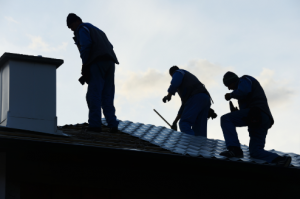How to Make Your Roof Watertight
Ensuring your roof is watertight is crucial for protecting your home from water damage. Water infiltration can lead to numerous issues, including structural damage, mold growth, and increased energy costs. Here, we provide a detailed guide on how to effectively make your roof watertight, emphasizing the necessary steps and factors to keep in mind during roof repair projects.
Understanding the Importance of Roof Repair
Roof repair is a critical task that ensures the longevity of your home. Water damage can start small but quickly escalate into costly problems.
Early repair work, especially focused on making your roof watertight, is a proactive measure. It not only saves money but also prevents potential safety hazards. Additionally, a watertight roof helps maintain energy efficiency, reducing heating and cooling costs over time.
A solid roof repair plan begins with understanding your current roofing situation. Assess areas where leaks might occur, such as around chimneys, skylights, and valleys. Not only does this allow for targeted repairs, but it also prioritizes resource allocation. Knowing the weak points in your roof will guide you in selecting suitable materials for repair. Each type of roofing material has unique characteristics that affect how it interacts with water.
Frequent inspections play an essential role in maintaining a watertight roof. Regular check-ups help in identifying minor problems before they turn into major concerns. By scheduling routine inspections, you can prevent severe damages. Inspect after significant weather events to catch any immediate issues. This proactive approach aligns with best practices in roof repair and maintenance.
Choosing the Right Materials
Using the right materials during roof repair is fundamental to achieving a watertight seal. Not all roofing materials offer the same level of protection against water. Selecting materials that are specifically designed to withstand harsh weather conditions is recommended. High-quality underlayment, sealing tapes, and durable shingles can significantly contribute to making your roof watertight. Each plays a crucial role in a comprehensive roof protection strategy.
Underlayment forms the primary defense between your roof deck and the elements. A high-performance synthetic underlayment provides superior water resistance compared to traditional felt. Sealing tapes should be applied along seam lines and edges to ensure no water can penetrate these vulnerable areas. When choosing shingles, prioritize those with higher wind and waterproof ratings. Remember, every element of your roofing system needs to contribute to the overall watertight seal.
Proper installation is just as important as material selection. Even the best materials can fail if not installed correctly. Hiring a professional with expertise in watertight roof installations is advisable. They can ensure every layer is placed correctly, maintaining the integrity of the roof repair. Whether you DIY or hire help, focusing on these elements will provide peace of mind and protect your home effectively.
Implementing a Regular Maintenance Schedule
Regular maintenance is critical to keeping your roof watertight over time. Even with the best materials and initial installation, routine inspections and upkeep are necessary. Addressing small issues promptly prevents them from growing into larger, more costly repairs. Seasonal changes and unexpected weather conditions can introduce new vulnerabilities. Regular maintenance helps adapt your protection strategies to these dynamics.
Create a schedule that aligns with seasonal changes to account for weather-specific threats. Fall and spring are excellent times for comprehensive checks and preventative maintenance. Clean gutters, inspect flashing, and check for loose or damaged shingles. Maintaining your roof involves not only visual inspections but also physical checks for structural integrity. Doing so helps sustain the effectiveness of your initial roof repair efforts.
Documentation is a key aspect of roof maintenance. Keeping a record of repairs, material changes, and inspection results helps track the roof’s condition. This data aids in making informed decisions when planning future repairs. It also simplifies communication with roofing professionals should specialist intervention be needed. With a robust record-keeping system, you ensure a proactive approach to roof care.
Sealing and Waterproofing Techniques
Applying proper sealing and waterproofing techniques is essential in the roof repair process. This step involves using specialized products that block moisture infiltration. Sealants are applied to joints, flashing, and any penetrations in the roofing system. Waterproof coatings add an additional barrier on the surface, enhancing the roof’s protection against the elements. These methods work in tandem to create a robust defense against water intrusion.
Choosing the right sealant is pivotal. Each sealant type is formulated for specific applications and must be compatible with your roofing materials. Waterproof coatings should be selected based on the climatic conditions of your location. For regions prone to intense sun exposure, UV-resistant coatings are ideal because they prevent degradation over time. Similarly, in wet climates, focus on coatings that offer high moisture resistance.
The application of these materials should be precise and thorough. Proper application ensures the longevity and effectiveness of your roof repair. Whether you’re sealing small gaps or applying a full-surface waterproof coating, attention to detail is crucial. It’s advised to enlist professional services for installing these products to ensure they are applied correctly and evenly, providing the best defense for your home’s roof.










